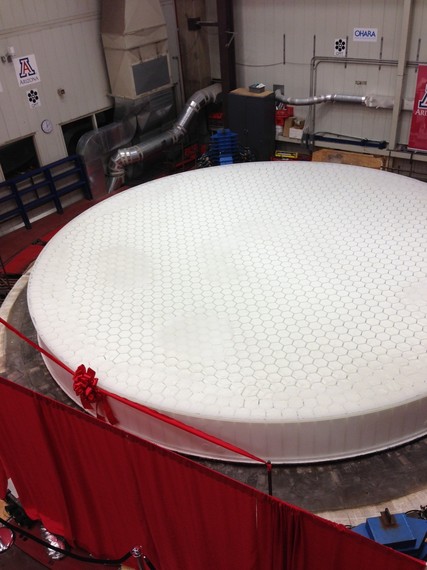Giant telescope aims to see first stars after the Big Bang
Some of humanity's most enduring and profound questions remain to be answered. What is the universe made of? When and how did the first stars and galaxies in the universe form? When did the first planets form? Is there life elsewhere in the universe?
Addressing these mysteries is the goal of a new generation of "Extremely Large Telescopes," or "ELTs," and a milestone in this challenging scientific and engineering enterprise was achieved last week in Tucson, Arizona. The Giant Magellan Telescope is now firmly on course to become the first of these ELTs. When completed, the GMT will combine the light gathering power of seven of the largest individual mirrors in the world. Overall, it will be 80 feet in diameter.
This new giant mirror has been locked within an unopened furnace since last August. From its peak temperature of 2100 degrees Fahrenheit, its temperature has been precisely controlled, cooling very slowly. The third of those mirrors has just been uncovered and shown to the public for the first time. But this unveiling is just the beginning -- this giant mirror will now require three years to polish and test before it will join its sibling mirrors in the telescope and open the doors to discovery.
The combined surface area of the first three mirrors alone already surpasses that of any existing telescope, and we will continue these castings until GMT reaches its full complement of seven mirrors in 2024. However, in 2020 with its first four mirrors in place GMT will see "first light" from the pristine skies of the Las Campanas Observatory high in the Andes mountains overlooking the Atacama Desert of Chile. At that time the GMT will be the largest optical telescope in the world.
To put the power of the GMT in perspective: It will be operating on the Earth's surface, but it will have images that are 10 times sharper than the Hubble Space Telescope and with 10 times its sensitivity. This is largely due to a recent technical marvel called adaptive optics. Just as noise-cancelling headphones rid you of unwanted airplane noise, adaptive optics removes the image blur caused by motion in the Earth's atmosphere.
Mirrors are the heart of any telescope. The GMT mirrors are innovative feats of daring design and enormous scale. They are indeed "Giant": Each mirror weighs nearly 20 tons and measures 27 feet in diameter. The glass for these mirrors is melted, molded and custom cast over several months in a computer-controlled spinning furnace. Once cooled the mirrors are polished with computer-assisted tools that meticulously smooth the surface so that to the unaided eye, the mirror is perfectly smooth. Any remaining imperfections are smaller than one millionth of an inch! If one of our mirrors were scaled up to the size of the continental United States, the height of the tallest peak on that surface would be only a half-inch high. This kind of exacting craftsmanship is critical in allowing us to unlock the mysteries of the cosmos.
As exciting as GMT's potential is, and as complex as its construction has been, the initiative itself may fundamentally change the way ambitious scientific research projects are undertaken. Ten international partners, primarily from the private sector, are working with philanthropists and governments from around the world to bring this $1 billion project to fruition. This combination of private initiative and public cooperation has never been attempted before, and it is the largest privately funded telescope initiative ever launched.
Fundamentally GMT is about understanding our place in the Universe. And it will be at the cutting edge of this continuing exploration for at least the next half century. We are equally excited about the other extremely large telescopes on the drawing boards around the world, and when they come online, the level of research and our overall understanding of so many of the universe's mysteries both stand to increase dramatically.
The milestone of our third mirror captures more than a moment in time, it heralds a rapidly approaching period of discovery. This is an exciting a moment for GMT, but it is also a time to be shared with all who wonder about our universe, our origins and our place within it. We have all heard about "20/20 hindsight." With GMT projected to come on-line in the year 2020, and given its natural ability to "look back" in time with unprecedented clarity and power, the notion of "2020 hindsight" will take on a much different meaning. And with the Giant Magellan Telescope we have taken one giant mirror step toward a giant telescope.

